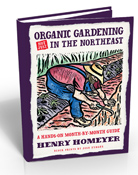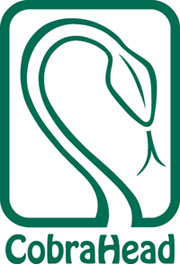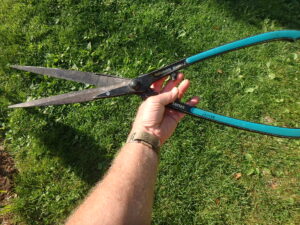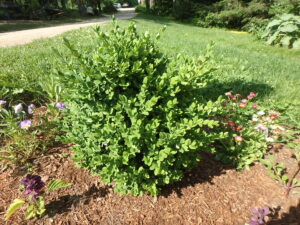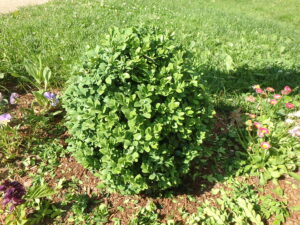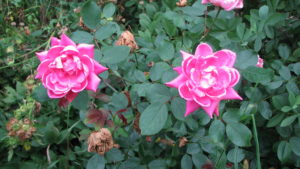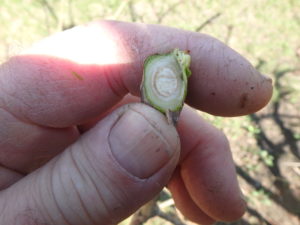It’s Time to Prune Trees and Shrubs
Make your cuts just into the green growth. By doing so you are leaving a growing point for new growth next spring. Most rhododendrons blossom on old wood, which is to say growth that occurred the year before.
British gardeners – and hence, many American gardeners – love boxwoods. They love hedges and portly round balls. Some even create rabbits and other silly sculpture called topiary. If you have boxwoods, they need a light haircut every year in June or July. Never prune them after August, because pruning stimulates new growth and it will be tender, and turn brown and ugly in winter.
When pruning boxwoods, just take a little off with each snip. You can work quickly, but just take a little at a time so you can get the exact shape you want and don’t create holes with a big cut.
What Your Roses, Peegee Hydrangeas and Lilacs Need Now
My roses are waking up, and starting to show leaf buds along their stems. This is a good time to cut back dead stems, which will stimulate new growth and start them off well for the summer season. It’s time to shape your roses so that they are as good-looking now as they were when you bought them.
When I was a boy, roses were fussy. My parents bought a house in the country in June, when all the roses were in bloom. Those roses, I imagine, helped clinch the deal. But within a few years they were gone. Diseases, bugs and beetles had ravaged them. We didn’t spray with toxic chemicals, and many of those roses depended on toxic sprays, I suppose.
Now breeders have created roses that rarely get black spot, and are not very attractive to rose chafers and Japanese beetles because they don’t have a strong floral scent. Sure, Japanese beetles sometimes find my bodacious pink or red blossoms, but I just pull them off the beetles and drop them in soapy water – or crush them.
My favorite series of roses are the ‘Knockout’ roses. These beauties start blooming in June, and continue to produce blossoms until hard frost. It’s not unusual for my plants to be blooming at Halloween. There are others that are probably just as good, so ask at your local family-owned garden center. ‘At Last’, a Proven Winner rose, is another favorite of mine, in part because it is lightly fragrant, too.
On a recent sunny afternoon I took my pruning shears and went outdoors to give my roses a haircut. It was a harsh winter, and many stems were dead near their tips, and a few canes were dead all the way back to the ground.
I took time to really look at the stems of the roses. What I wanted to do was remove the dead material back to the highest bud that was alive and active – and outward facing. I looked for signs of life, which were buds starting to produce leaves. Dead stems are generally brown, and live stems are green or reddish.
How should you make your cut? On an angle, just a little above a bud. Look at the piece you cut off. If it is brown all the way through, you are looking at dead wood. You should cut lower down the stem until you see a layer of green just beneath the bark.
If you had a stem or two last year that grew more vigorously than the others, you may wish to cut them back past the first green bud. What I want is a well-balanced plant, not a lopsided plant, or one with a very tall leader. Some rosarians (rose-obsessed gardeners) like to cut back most stems to within 6 inches of the ground, and let the entire bush grow up each year from the ground.
Some roses bloom on old wood, not new growth. Rugosa or beach roses are like that, as well as some once-a-season old fashioned roses. Those are best pruned for shape of the bush after blooming, but dead wood can be taken out now.
This summer you will want to snip off spent blossoms. After blooming, cut back the stem to a mature leaf cluster which has 5 or 7 leaves. Cutting back to clusters of only 3 leaves won’t stimulate the rose to re-bloom.
A word on fertilizing. I am not keen on fertilizing roses, as it tends to make them grow too fast. Often fast growth is weak, with stems that flop. But if you feel you need to fertilize, do so after the first flush of blossoms, not now. Re-blooming roses like the Knockouts tend to re-bloom every 5 to 6 weeks.
I admit to being negligent when it comes to pruning back my PeeGee hydrangea, so this year I have given it a good hard prune. It’s best to do while the plant is still dormant, or just waking up. I cut last year’s stems that blossomed back to big, fat older stems. These hydrangeas bloom on new wood, and pruning now will stimulate new growth – and lots of blossoms. The PeeGee is a shrub, but can get too tall and wide unless you prune it.
When pruning, you will find some stems that are dead near their tips. Cut those back until you see a layer of green beneath the bark. That indicates that it is alive there. As with roses, always cut back to just above a bud, or to a bigger branch.
Remove any spindly, weak branches, or any that aim back into the middle of the plant. If you have branches that have the potential to poke someone in the eye, cut them back!
Do not hesitate to prune your hydrangeas hard. Decide what size plant works best in the space you have, and prune until you have reached the right size. You won’t kill your plant by pruning. Opening up the middle of a shrub allows more sunlight to reach the leaves, which helps prevent fungal diseases.
Lilacs will be blooming soon, so you may want to wait until after they bloom to prune them. Pruning now just means that you will have fewer blossoms this spring. But if you want to help your lilacs to have better blossoms next year, spread some limestone or wood ashes in a circle around them. Lilacs like neutral or slightly alkaline soil, and limestone helps to achieve that.
Pruning, to me, is like sculpting. Done well, it creates plants that are gorgeous – even when they are not in bloom.
Henry can be reached at henry.homeyer@comcast.net. Read his blog posts at https://dailyuv.com/gardeningg

